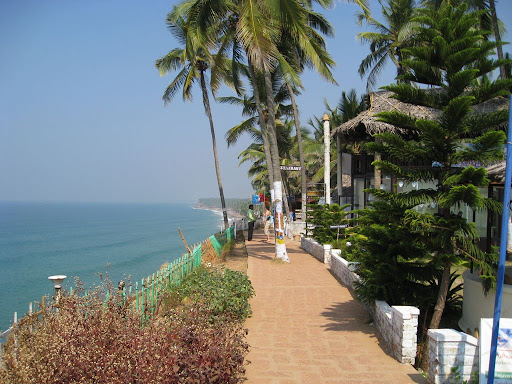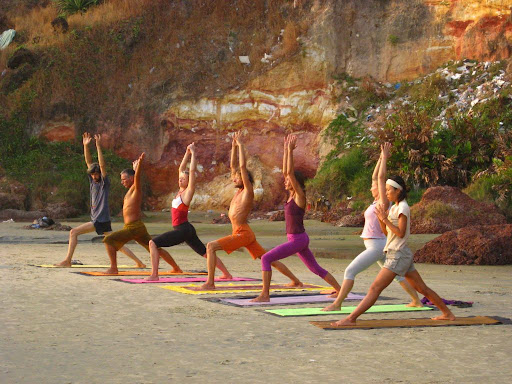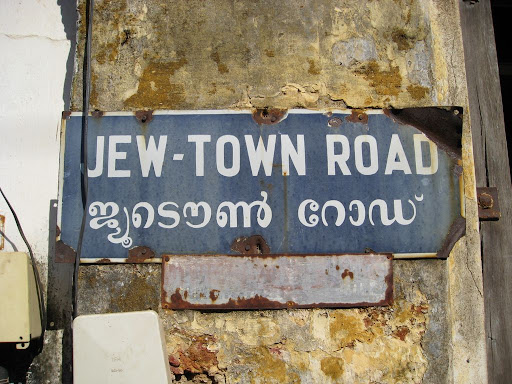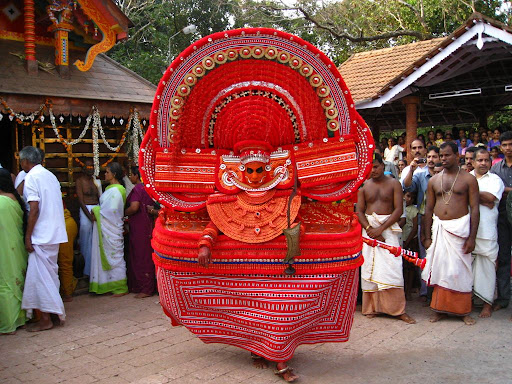Kerala is pretty unique among the Indian states. It is isolated from the rest of the country by a huge mountain range, which has allowed it to develop its own language, culture, cuisine, etc... With the port city of Cochin, it has had a good deal of regular contact with the outside world. Its jungles are home to about 60% of India's spices, making trade a huge industry historically (this is the Malabar coast). The beaches are pretty great too.
We arrived in the capital city of Tiruvananthapuram (or Trivandrum for short....) A Chinese business man I had met while waiting in line for my Indian visa in Beijing told me that this town was one of his favorite in the country, and that I HAD to visit. He told me the name in Chinese, not English (which wasn't very helpful), so when I was in Hong Kong I found a map of India in the public library with Chinese characters I figured out which city he was actually talking about. Normally I would be extremely skeptical of this suggestion because in my experience Chinese people are terrible tourists and have no grasp of the reality of what they are seeing. A good city for a Chinese tourist is often one that has been completely destroyed and exploited but probably has a few nice photo-ops and a good place to buy a tacky souvenir. However, another Chinese girl in line overheard our conversation and agreed, insisting that I visit this great city.... As it turns out, there is nothing interesting about Trivandrum. We had a few tasty meals and visited a beautiful zoo where we saw our first elephants (it kills me that this is where we have to see our Indian elephants) We also enjoyed the unique Keralan architecture, and a decent temple.
for a Chinese tourist is often one that has been completely destroyed and exploited but probably has a few nice photo-ops and a good place to buy a tacky souvenir. However, another Chinese girl in line overheard our conversation and agreed, insisting that I visit this great city.... As it turns out, there is nothing interesting about Trivandrum. We had a few tasty meals and visited a beautiful zoo where we saw our first elephants (it kills me that this is where we have to see our Indian elephants) We also enjoyed the unique Keralan architecture, and a decent temple.
The next morning before getting on a train to leave the city, Cameron and I woke up early to visit a Kalarippayattu school where Kerala's 5,000 year old martial art is still taught and practiced. It was only a training session, but it brought back a flood of nostalgia of when I used to be active in martial arts. Seeing the strength, flexibility, and agility of the practitioners made me pretty disappointed in how lazy I have gotten. The art form is a combination of fighting techniques, traditional weaponry, dance, and Hindu ritual - pretty fascinating. I left the school motivated to seek out a new discipline for myself, and being in India, it seemed yoga would be a perfect start if I could find a place to study it.
 After almost three weeks of exhausting, non-stop travel, we decided that our next destination should be a relaxing one. We went to a town called Varkala, a very laid back beach village perched atop a huge cliff overlooking the Arabian Sea. My first impression made me think of Thailand, but Varkala seemed less destroyed by the hordes of tourists that descend upon the poor Thai beaches. We walked along the path which follows the edge of the cliff to find a place to stay, and we ended up talking to a few Indians who wanted to practice their English/sell us things - there is no way to tell until they get to the point - "so..... do you want me to organize a trip to the backwaters for you???" I could talk for hours about how terrible the Indian touts and hawkers are, but I think I've vented enough about them in other posts.
After almost three weeks of exhausting, non-stop travel, we decided that our next destination should be a relaxing one. We went to a town called Varkala, a very laid back beach village perched atop a huge cliff overlooking the Arabian Sea. My first impression made me think of Thailand, but Varkala seemed less destroyed by the hordes of tourists that descend upon the poor Thai beaches. We walked along the path which follows the edge of the cliff to find a place to stay, and we ended up talking to a few Indians who wanted to practice their English/sell us things - there is no way to tell until they get to the point - "so..... do you want me to organize a trip to the backwaters for you???" I could talk for hours about how terrible the Indian touts and hawkers are, but I think I've vented enough about them in other posts.
We spent the next four days following this demanding schedule:
- Wake up
- Eat
- Go to the beach
- Eat
- Go to the beach again
- Eat
- Sleep
Pretty awful...
The landscape is pretty volcanic - black sand beaches and bright red porous stones and cliffs - which makes for an especially beautiful sunset. The shore is lines with tall palms, from which machete-wielding vendors gather coconuts to sell to beach-goers. Being a seafront village, there is an abundant supply of cheap, fresh seafood. We spent our entire stay gorging ourselves on tuna steaks, lemon and garlic grilled red snapper, and tandoori barbecued butterfish, barracuda, and pomfret. (One of the best ways I've eaten fish by the way..) A whole fish, including rice and naan would cost a little less than 5 bucks..
The town is also a site for Hindu pilgrims, and it seems some local yoga practitioners have found a tourist niche. All along the cliff the hotels use their roofs for yoga lessons. Although this wasn't the ideal ashram in the jungle mountains that we had hoped for, the relaxed environment and peaceful surroundings made it a good enough place for us to take a few lessons. Our instructor was a short Indian man who had a high pitched, accented voice which reminded me a lot of the Maharishi's. We completed an hour and a half session involving meditation, breathing exercises, and some mercilessly painful yoga asanas. After the quite humbling experience, we ran down to the beach at the bottom of the cliff and dove into the beautifully cool sea, where some serious European shantis were enjoying the sunset while meditating, doing yoga, having group consciousness circles, and smoking their way to enlightenment.
Maharishi's. We completed an hour and a half session involving meditation, breathing exercises, and some mercilessly painful yoga asanas. After the quite humbling experience, we ran down to the beach at the bottom of the cliff and dove into the beautifully cool sea, where some serious European shantis were enjoying the sunset while meditating, doing yoga, having group consciousness circles, and smoking their way to enlightenment.
After being sufficiently reinvigorated, we decided that we were ready to return to the insanity of 'actual' India. We took a train to a small and terrible town called Kollam, where we hopped on a boat that took us through the Kerala backwaters to another town called Alleppey. The trip was very pleasant, although not as mind blowing as people say it is. We were expecting "the most incredible place in India" as all of the guidebooks promise, but in reality it was just an enjoyable cruise past rural farmland, plantations, and river villages. I think if you have enough money to rent a rice boat for a few days you can experience the true glory of the backwaters, but we didn't have that luxury (everyone we saw on rice boats seemed to be 60-year-old wealthy English people).
From Allepey, we took a bus to Kochi (formerly Cochin) - a main Indian port of the spice trade throughout history. I would actually describe the city as charming - a very rare adjective to use for India. I explored the colorful streets with hints of the European architecture of the city's former inhabitants and walked down to the area of the city called "Jew Town". One of Asia's few Jewish populations is still holding on here in a community that has existed continuously since the 15th century. Jewish names are displayed outside local shops, and the people themselves look like any typical European-Israelis, except for the fact that they speak the local language Malayalam and have completely adopted Indian mannerisms. Very peculiar.
One of Asia's few Jewish populations is still holding on here in a community that has existed continuously since the 15th century. Jewish names are displayed outside local shops, and the people themselves look like any typical European-Israelis, except for the fact that they speak the local language Malayalam and have completely adopted Indian mannerisms. Very peculiar.
We took advantage of the Western influence and had some Italian food before taking a ferry to the mainland to catch a train. We stopped in at a bookstore and gluttonously stocked up on about six books each. (Too cheap to resist, and China doesn't have English books --- anywhere..)
Our next destination was a place called Kannur, which is known for its elaborate theyyam performances. Local Hindu temples in the area have extended celebrations that honor a specific deity or hero - the entire community gathers at the temple, and someone is designated to play the role of the deity. This individual engages in a ritual fast and purification period leading up to the day of the offering, when he is put into a trance and is dressed in an unbelievably elaborate costume and intricately detailed makeup. The ceremony usually begins around midnight and lasts around 12 hours. The entranced performer is possessed by the spirit of the deity and engages in a series of dances and blessings, which are accompanied by the rhythmic drumming of a group of young men who follow him around the temple courtyard.
We found out were one of these performances was going to take place, and we took a bus to the village - about 20 minutes away from Kannur. We asked around in the village for directions to the temple, but when we arrived there was nothing going on. A few men who were working there gave us directions in Malayalam to another nearby temple that was having a theyyam, but since we had no clue what they were saying to us, we just walked back to the road and found someone who spoke English. We took a rickshaw to another temple in the next town over, and as we drove up we could hear the drumming in the distance and a stream of locals walking from the direction of the sound. We pulled up to the temple, and there were hundreds of people gathered around the courtyard. There were one or two other tourists - at most - in a crowd of probably 600 Indians, so we knew that this was the real deal. And it was more incredible than I could have ever imagined it. Very authentic and very moving. The energy in the air as we walked around the temple barefoot, swaying with the movement of the crowd, was intense - the beat of the drums almost pulls you into the theyyam trance of the deity spirit.
We pulled up to the temple, and there were hundreds of people gathered around the courtyard. There were one or two other tourists - at most - in a crowd of probably 600 Indians, so we knew that this was the real deal. And it was more incredible than I could have ever imagined it. Very authentic and very moving. The energy in the air as we walked around the temple barefoot, swaying with the movement of the crowd, was intense - the beat of the drums almost pulls you into the theyyam trance of the deity spirit.
After a thoroughly enjoyable time in Kerala, we hopped on another bus over the dramatic Western Ghats mountain range into the neighboring state of Karnataka.
We arrived in the capital city of Tiruvananthapuram (or Trivandrum for short....) A Chinese business man I had met while waiting in line for my Indian visa in Beijing told me that this town was one of his favorite in the country, and that I HAD to visit. He told me the name in Chinese, not English (which wasn't very helpful), so when I was in Hong Kong I found a map of India in the public library with Chinese characters I figured out which city he was actually talking about. Normally I would be extremely skeptical of this suggestion because in my experience Chinese people are terrible tourists and have no grasp of the reality of what they are seeing. A good city
The next morning before getting on a train to leave the city, Cameron and I woke up early to visit a Kalarippayattu school where Kerala's 5,000 year old martial art is still taught and practiced. It was only a training session, but it brought back a flood of nostalgia of when I used to be active in martial arts. Seeing the strength, flexibility, and agility of the practitioners made me pretty disappointed in how lazy I have gotten. The art form is a combination of fighting techniques, traditional weaponry, dance, and Hindu ritual - pretty fascinating. I left the school motivated to seek out a new discipline for myself, and being in India, it seemed yoga would be a perfect start if I could find a place to study it.
We spent the next four days following this demanding schedule:
- Wake up
- Eat
- Go to the beach
- Eat
- Go to the beach again
- Eat
- Sleep
Pretty awful...
The landscape is pretty volcanic - black sand beaches and bright red porous stones and cliffs - which makes for an especially beautiful sunset. The shore is lines with tall palms, from which machete-wielding vendors gather coconuts to sell to beach-goers. Being a seafront village, there is an abundant supply of cheap, fresh seafood. We spent our entire stay gorging ourselves on tuna steaks, lemon and garlic grilled red snapper, and tandoori barbecued butterfish, barracuda, and pomfret. (One of the best ways I've eaten fish by the way..) A whole fish, including rice and naan would cost a little less than 5 bucks..
The town is also a site for Hindu pilgrims, and it seems some local yoga practitioners have found a tourist niche. All along the cliff the hotels use their roofs for yoga lessons. Although this wasn't the ideal ashram in the jungle mountains that we had hoped for, the relaxed environment and peaceful surroundings made it a good enough place for us to take a few lessons. Our instructor was a short Indian man who had a high pitched, accented voice which reminded me a lot of the
After being sufficiently reinvigorated, we decided that we were ready to return to the insanity of 'actual' India. We took a train to a small and terrible town called Kollam, where we hopped on a boat that took us through the Kerala backwaters to another town called Alleppey. The trip was very pleasant, although not as mind blowing as people say it is. We were expecting "the most incredible place in India" as all of the guidebooks promise, but in reality it was just an enjoyable cruise past rural farmland, plantations, and river villages. I think if you have enough money to rent a rice boat for a few days you can experience the true glory of the backwaters, but we didn't have that luxury (everyone we saw on rice boats seemed to be 60-year-old wealthy English people).
From Allepey, we took a bus to Kochi (formerly Cochin) - a main Indian port of the spice trade throughout history. I would actually describe the city as charming - a very rare adjective to use for India. I explored the colorful streets with hints of the European architecture of the city's former inhabitants and walked down to the area of the city called "Jew Town".
We took advantage of the Western influence and had some Italian food before taking a ferry to the mainland to catch a train. We stopped in at a bookstore and gluttonously stocked up on about six books each. (Too cheap to resist, and China doesn't have English books --- anywhere..)
Our next destination was a place called Kannur, which is known for its elaborate theyyam performances. Local Hindu temples in the area have extended celebrations that honor a specific deity or hero - the entire community gathers at the temple, and someone is designated to play the role of the deity. This individual engages in a ritual fast and purification period leading up to the day of the offering, when he is put into a trance and is dressed in an unbelievably elaborate costume and intricately detailed makeup. The ceremony usually begins around midnight and lasts around 12 hours. The entranced performer is possessed by the spirit of the deity and engages in a series of dances and blessings, which are accompanied by the rhythmic drumming of a group of young men who follow him around the temple courtyard.
We found out were one of these performances was going to take place, and we took a bus to the village - about 20 minutes away from Kannur. We asked around in the village for directions to the temple, but when we arrived there was nothing going on. A few men who were working there gave us directions in Malayalam to another nearby temple that was having a theyyam, but since we had no clue what they were saying to us, we just walked back to the road and found someone who spoke English. We took a rickshaw to another temple in the next town over, and as we drove up we could hear the drumming in the distance and a stream of locals walking from the direction of the sound.
After a thoroughly enjoyable time in Kerala, we hopped on another bus over the dramatic Western Ghats mountain range into the neighboring state of Karnataka.

2 comments:
The pace may be slower in Karala, but the writing remains wonderful.
Your legions of readers back here enjoy every new adventure.
Max, this blog must be published sometime soon.
BTW, your days in Karala sound a lot like my days in Key West...
Miss you, can't wait until we hear these stories in person in April!
Dad
BTW, if your yoga teacher really sounded like Maharishi, he would have giggled and laughed a lot...
Post a Comment